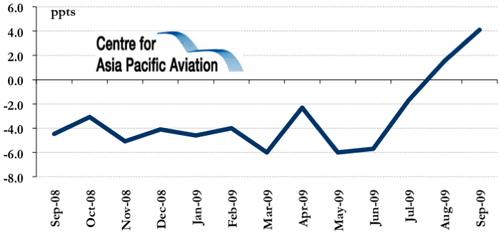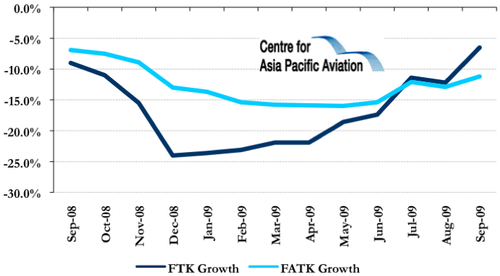AAPA sees improved Sep-2009 traffic, but “significant challenges” still exist
Asia Pacific full service airlines reported "encouraging" traffic results in Sep-2009, according to the Association of Asia Pacific Airlines (AAPA). Director General, Andrew Herdman, stated the figures "offer some encouragement amidst signs of a continuing pickup in consumer confidence and economic activity, led by the Asia Pacific region".
However, he warned that "airlines are still facing significant challenges" and that "recovery still looks quite fragile", with shrinking traffic volumes, combined with lower yields, negatively affecting revenues and profitability. Mr Herdman added that despite capacity cutbacks and other cost reduction efforts, "airlines are still struggling to restore profitability".
Passenger reductions only marginal in Sep-2009
AAPA members carried a total of 10.8 million international passengers in Sep-2009, a 0.2% year-on-year contraction. It effectively matches the numbers carried in the same month in the preceding year for the first time in over 12 months.
AAPA passenger traffic (RPK) growth and passenger load factor: Sep-2008 to Sep-2009
Traffic (RPKs) in Sep-2009 declined 0.9%, although this marked a "significant improvement" compared to the steep monthly declines recorder over the past 12 months.
AAPA RPK growth and ASK growth: Sep-2008 to Sep-2009
Second consecutive months of load factor improvements
In other positive news, the member carriers experienced a 4.1 ppt improvement in international passenger load factors to 76.4% in the month, following a 1.5 ppt improvement in the previously month, as the carriers reduced capacity (ASKs) by 6.1%. The load factor improvement in Aug-2009 and Sep-2009 follow over 12 months of declines for AAPA airlines.
AAPA passenger load factor growth: Sep-2008 to Sep-2009
Air cargo continues slow recovery in Sep-2009
Air cargo traffic volumes also "continued its slow recovery" in Sep-2009, according to AAPA.
In the month, AAPA international freight tonne kilometers (FTKs) were down 6.5%, for the smallest shortfall so far in 2009. It is an improvement from a contraction of 12.2% in the previous month and an improvement from the accumulative decline of 18.1% in the nine months to Sep-2009. The average international cargo load factor rose 3.4 ppts to 68.7% in the month, as carriers cut capacity by 11.2%.
AAPA FTK growth and FATK growth: Sep-2008 to Sep-2009
Outlook: Airlines reduces fares to stimulate demand, placing further pressure on yields and profitability
In attempting to navigate their way through the current crisis, Asia Pacific airlines have been cutting capacity, focusing on cost reduction efforts and discounting fares to stimulate demand in a weak demand environment. While this strategy has had some success in stimulating demand, it has also placed considerable pressure on yields, resulting in "sharply lower revenues and heavy losses for most carriers".
Mr Herman concluded that "as things stand now, the recovery still looks quite fragile".



